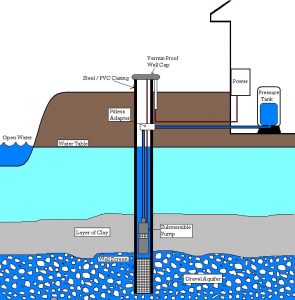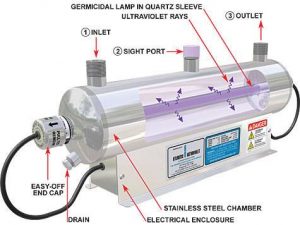Coliform bacteria is a large group with many different kinds of bacteria. Most Coliform bacteria are harmless. Various types of Coliform live in the soil and even on surfaces in your home, but they do not occur naturally in groundwater. If Coliform bacteria (sometimes reported as Total Coliform) are found in your well water, it is an indication that disease-causing bacteria could get in the same way. If any Coliform bacteria are found, the lab does a second test to look for the special sub-group of Coliform that live in the guts of mammals and birds. This test is for E. coli or Fecal Coliform. These bacteria indicate that your well water has come into contact with animal waste indicating a very high risk for transmitting disease.
POTENTIAL CAUSES OF BACTERIA IN YOUR WELL WATER
- Problems with the top of the well. Is the cap loose? Are there any open holes in the cap? Are there cracks or holes in the well pipe? If you find any of these problems, this could be the source of bacteria. Fix the problem first, then shock chlorinate the well. Test again before using the water.
- Work was done recently on the well, pump, or plumbing system. If the water system was not disinfected after the work, this may be your source of bacteria. Shock chlorinate your water system and test the water again.
- Water standing next to the well. If the area around the well pipe (casing) gets wet, this water may be causing your problem. Make sure that runoff water does not reach the well. The presence of bacteria also means that there may be problems with the grout seal around the well pipe. If you can’t find any other explanation for the bacteria, contact a well contractor to advise you on repairing the grout seal.
- The sample was contaminated in the collection process. Common problems include: (a) A hose, aerator screen, filter or other attachment on the faucet. (b) Accidentally touching the inside of the lid or the top of the bottle. (c) Not running the water 3-5 minutes before collecting it. Carefully collect another sample and retest. Use rubbing alcohol on a clean paper towel to wipe the faucet before letting the water run for 3-5 minutes.
- A movable faucet. Sometimes bacteria grow at the swivel point. This is not harmful, but still shows up in the test. If the sample was from a movable faucet, do the test again using another faucet.
- The well is shallow, especially if near a stream or pond. The well may be drawing water from the surface. To avoid bacteria in drinking water: (a) Use either a UV, chlorine or ozone water-treatment system, or (b) find another source of water, such as drilling a deeper well.
- Storage tank or pipes that are not water tight. Make sure there is no way for surface water to enter your drinking water system.
- Old, unused wells. Old wells in the area may be draining bacteria into the groundwater. Check with a well contractor about sealing up unused wells.
- Septic system or animal waste close to the well. This is a problem only if Fecal Coliform or E. coli was found. Check for other problems described above. Bacteria need a way to get into the water system which needs to be fixed.
IF BACTERIA COMES BACK AFTER SANITIZING
Ultraviolet light (UV) water purification systems can be an effective bacterial control and water sanitizing technology.
UV is a type of energy found in the electromagnetic spectrum, lying between x-rays and visible light. Although we cannot see UV light or rays, we are exposed to them every time we step out into the sun. In fact, UV light is responsible for causing sunburns. Ultraviolet systems use special lamps or bulbs that emit UV light of a particular wavelength. The Ultraviolet energy attacks the genetic core of the microorganism and rearranges the DNA /RNA eliminating the microorganism’s ability to function and reproduce. If the microorganism can no longer reproduce, it cannot replicate, therefore it cannot infect other organisms with which it has contact. The process is simple but effective, destroying 99.99% of harmful microorganisms without adding chemicals to the water.
See the following link for more description of Ultraviolet light (UV) water filtration technology https://h2ocare.com/ultraviolet-uv-light-disinfection/ or for even more detail go to http://www.water-research.net/Waterlibrary/privatewell/UVradiation.pdf.



